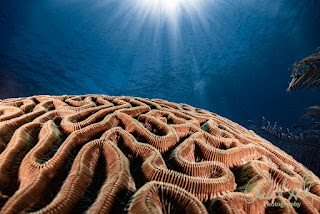Packing Essentials for an Underwater Photography Travel Trip
As a Photo Pro at Turquoise Divers, a Dive Resort located in Roatan, Honduras, I have the pleasure of welcoming new groups of divers each week to explore the beautiful reef. Among these groups, there are always several photographers or videographers who are part of the diving experience. I often find myself being asked if I have spare batteries, various cables (such as USB, Fiber Optic, and TTL), storage devices, desiccants like silicon gel packs, case straps or lanyards, and other accessories.
In this week's blog post, I am focusing on a list of some of the equipment that a traveling underwater photographer/videographer might need to pack before leaving for their dive destination. Remember, you are dedicating lots of money and time for this trip, the last thing you need is to forget some critical item that is necessary to capture your memories while on this trip.
As a professional underwater photographer, meticulous packing is crucial for a successful trip. Having the right equipment for various camera types can mean the disparity between capturing stunning shots and missing out on extraordinary underwater moments. Whether you're utilizing a smartphone with a housing, a point-and-shoot underwater camera, or an advanced SLR or mirrorless system, here’s a comprehensive guide to assist you in packing efficiently.
1. Smartphones with Underwater Housings
Smartphones have become increasingly capable of underwater
photography, especially with dedicated housings. Here’s what you need:
Equipment:
- Waterproof
smartphone housing: Choose reliable housing like Kraken or SeaLife
SportDiver that provides easy access to your phone's features underwater.
- Backup
O-rings: These small, but crucial components ensure the waterproof
seal of your housing. Always carry spares.
- O-ring
lubricant: Keeps your O-rings supple and effective, preventing leaks.
- Lanyard
or wrist strap: To secure your phone and prevent accidental drops in
the water.
- Touchscreen-compatible
gloves: Allow you to operate your phone's touchscreen while
underwater, ideal for colder waters.
Accessories:
- Mini
tripod or grip handle: For stability and ease of use, especially in
deeper or surge-prone waters.
- Underwater
lens attachments: Macro and wide-angle lenses enhance your
smartphone’s camera capabilities.
- Waterproof
phone case: For surface use, protect your phone from splashes and
wet conditions.
- Anti-fog
inserts: Prevent your housing lens from fogging, ensuring clear shots.
Power:
- Portable
power bank: A must for recharging your phone on the go, especially on
long-dive days.
- Spare
phone battery: If your phone allows battery swaps, bring extras.
- Waterproof
power bank case: Protects your power bank from water exposure.
- Charging
cables: Multiple cables to ensure you can recharge all your devices.
Storage:
- High-capacity
microSD cards: Ensure you have ample storage for photos and videos.
- Waterproof
microSD card case: Keeps your cards safe and organized.
2. Point-and-Shoot Underwater Cameras (e.g.,
SeaLife, Olympus Tough Series)
These cameras are user-friendly and designed for underwater
use, with or without additional lighting.
Equipment:
- Camera
body: Choose a rugged, waterproof model like the SeaLife DC2000 or
Olympus Tough TG-6.
- Waterproof
housing: If your camera isn't inherently waterproof, dedicated
housing is essential.
- Backup
O-rings: Always have spare O-rings to ensure the housing remains
watertight.
- O-ring
lubricant: Regularly lubricate O-rings to maintain their
effectiveness.
- Wrist
strap or float strap: Prevents losing your camera in the water.
- Built-in
or external strobe: For better lighting, especially in deeper or murky
waters.
Lighting:
- Underwater
video light or strobe: Enhances visibility and color in your shots.
- Extension
arms and mounts: Allow flexible positioning of lights for optimal
illumination.
- Extra
batteries: Always carry spares for both your camera and lights.
- Battery
chargers: Ensure you can recharge all your batteries nightly.
Accessories:
- Lens
cover or cap: Protects your lens from scratches and debris.
- Anti-fog
inserts: Essential for clear, fog-free shots.
- Cleaning
cloth and solution: Keep your lens and housing clean.
Power:
- Spare
camera batteries: Essential for uninterrupted shooting.
- Portable
power bank: Additional power for longer trips.
- Charging
cables: Multiple cables to ensure all devices can be charged.
Storage:
- High-capacity
SD cards: Store large amounts of high-resolution photos and videos.
- Waterproof
SD card case: Protects your cards from water damage.
3. SLR and Mirrorless Cameras with Underwater Housings
These systems
offer unparalleled image quality and control for professional and advanced photographers.
Equipment:
- Camera
body: High-quality models like the Nikon D850 or Sony A7R series.
- Underwater
housing: Specific to your camera model, brands like Nauticam or
Ikelite are reliable.
- Dome
ports and flat ports: For different types of photography (e.g., macro,
wide-angle).
- Backup
O-rings: Critical for maintaining a watertight seal.
- O-ring
lubricant: Regularly applied to keep O-rings functional.
- Focus
and zoom gears: Necessary for controlling lens functions within the
housing.
- Extension
rings: For accommodating different lens and port combinations.
Lighting:
- Underwater
strobes: Brands like Inon and Sea & Sea offer powerful options.
- Underwater
video lights: Provide continuous lighting for video shooting.
- Extension
arms and clamps: For positioning your lights effectively.
- Sync
cables or fiber optic cables: For connecting your strobes to the
camera.
- Diffusers:
Soften strobe light, reducing harsh shadows.
Accessories:
- Lens
cover for ports: Protects your dome and flat ports.
- Anti-fog
inserts: Essential for clear shots.
- Vacuum
pump system: If your housing supports it, a vacuum pump helps ensure a
watertight seal.
- Maintenance
kit: Includes brushes, cloth, lubricants, and tools for minor repairs.
Power:
- Spare
camera batteries: For extended shooting sessions.
- External
battery pack: If applicable, for extended power.
- Battery
chargers: For all your batteries, ideally dual or multi-slot chargers.
- Spare
strobe and light batteries: Ensure your lighting is always ready.
Storage:
- High-capacity
and high-speed SD/CF cards: For fast and reliable storage.
- Waterproof
card case: Protects your cards from water and physical damage.
- Hard
drive or SSD: For backing up your photos and videos.
Common Items for All Camera Types
Computers and Storage:
- Laptop
or tablet: For editing and backing up your images. Ensure it has
enough processing power for your software (e.g., Lightroom, Photoshop).
- External
hard drives or SSDs: For backing up your images. Consider rugged,
waterproof models.
- USB
flash drives: Convenient for quick file transfers.
- Memory
card readers: Ensure compatibility with your memory cards.
- Waterproof
cases for electronics: Protect your devices from water and physical
damage.
Cables and Power Supplies:
- USB
cables (various types): For connecting and charging devices.
- Power
strips and surge protectors: These are especially useful in locations with
limited power outlets.
- International
plug adapters: Essential for charging devices in different countries.
- Spare
charging cables: Always have backups for all your devices.
Miscellaneous:
- Silica
gel packs: Help control moisture in your camera bags and cases.
- Waterproof
bags: For storing wet gear separately from dry items.
- Travel-sized
cleaning kits: Include lens cleaning cloths, solutions, and brushes.
- Notebook
and pen: For dive logs, notes, and planning.
- Portable
photo editing software: Ensure you have your software installed and
ready for use.
- Flash-light: Use this to inspect and ensure proper seating of o-rings on strobes, underwater housings, and video lights.
- Specialty batteries: for use inside underwater housings and flash converters for optic cables.
Final Tips
- Double-check
your O-rings: Ensure they are clean, lubricated, and properly seated
to avoid leaks.
- Backup
your photos daily: Use multiple storage devices to prevent data loss.
- Keep
essentials accessible: Items like chargers, spare batteries, and
memory cards should be easily reachable in your carry-on.
- Pack
light but smart: Prioritize items based on your shooting plan and
destination specifics.
Packing for an underwater photography trip requires attention to detail, but being well-prepared ensures you can focus on capturing the stunning underwater world without any equipment worries. Happy diving and shooting!
Subscribe to my blog for more tips and tutorials on underwater photography. Don’t forget to share your processed photos on social media using the hashtag #RobertHerbPhotography. I look forward to reviewing your results.
New Online Training Program
I am excited to announce that I am creating an online training program to teach underwater hobbyists and enthusiasts how to enhance their photos using Adobe Lightroom. If you are interested in this training, please contact me at bob@robertherb.com to express your interest and to be notified about the details and start date of the classes.
Feel free to reach out at bob@robertherb.com if you have any questions or need further advice on underwater photography gear. Safe travels and fantastic dives!
Stay tuned and "Follow" for upcoming blogs on underwater photography tips and tricks for more in-depth insights. Please leave your comments and suggestions. Enjoy your diving and shooting experience!
I am eagerly anticipating your valuable feedback and suggestions.
Sincerely,
Bob Herb
|
|





Comments
Post a Comment
Please let me know your comments.